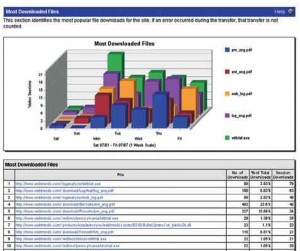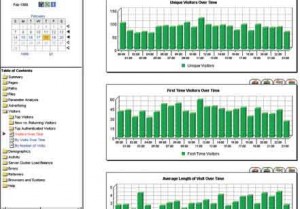Evaluating the corporate Web site that you are developing or maintaining is an important part of any successful implementation effort. Analysts can use the information system utility approach previously described to assess the aesthetic qualities, content, and delivery of the site. As an analyst or Webmaster, you should go one step further and analyze Web traffic.
A visitor to your Web site can generate a large amount of useful information for you to analyze. This information can be gathered automatically by capturing information about the source, including the previous Web site the user visited and the keywords used to find the site; the information can also be obtained through using cookies (files left on a user’s computer about when they last were on the site).
A leading Web activity monitoring package is Webtrends. Figure below is a sample report showing the most downloaded files on the Web site by day of the week. The graph displays the top five downloaded files, and the table at the bottom is a sorted list of all downloads. An analyst or Webmaster can gain valuable information by using a service such as Webtrends.

(Although some services are free, the pay services usually provide the detail needed to evaluate the site in depth. The cost is an ongoing budget item for maintaining the Web site.) Information to help you evaluate your client’s site and make improvements is plentiful and easy to obtain. The seven essential items are described next.
- Know how often your client’s Web site is visited. The number of hits a Web site had in the last few days, the number of visitor sessions, and the number of pages visited are a few of the general things you need to know.
- Learn details about specific pages on the site. It is possible to get statistics on the most requested pages, most requested topics, top paths a visitor takes through the client’s Web site, or even the most downloadable files. If the Web site is a commercial one, shopping cart reports can show how many visitors were converted into buyers and how many abandoned their carts or failed to complete the checkout process.
- Find out more about the Web site’s visitors. Visitor demographics and information such as the number of visits by a particular visitor in a period of time, whether the visitor is a new or a returning one, and who the top visitors are—all are valuable information when evaluating a Web site. The display in Figure below shows the number of unique visitors (top graph), the number of first-time visitors (middle graph), and the average length of visits over time (bottom graph).

A report comparing statistics on visitors generated by Commerce Trends (from Webtrends Corporation). - Discover if visitors can properly fill out the forms you designed. If the error rate is high, redesign the form and see what happens. Analysis of the statistics will reveal whether bad form design was to blame for errors in response.
- Find out who is referring Web site visitors to the client’s site. Find out which sites are responsible for referring visitors to the client’s Web site. Get statistics on the top referring site, the top search engines leading to the site, and even the keywords visitors used to locate your client’s Web site. After promoting a site, you can use Web traffic analysis to track whether the site promotion really made a difference.
- Determine what browsers visitors are using. By knowing what browsers are being used, you can add browser-specific features that improve the look and feel of the site and encourage visitors to stay longer, thereby improving the stickiness of the site. It helps to know whether visitors are using current or outdated browsers.
- Find out if the client’s Web site visitors are interested in advertising. Finally, find out if visitors to the site are interested in the ad campaigns you have on your site, such as offering a product for sale for a specific period.
Web activity services can be helpful in evaluating whether the site is meeting its stated objectives in terms of traffic, advertising effectiveness, employee productivity, and return on investment. It is one of the ways an analyst can evaluate whether the corporate Web presence is meeting management goals and whether it accurately portrays the organization’s vision.

